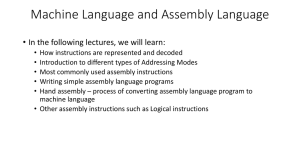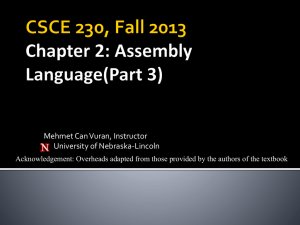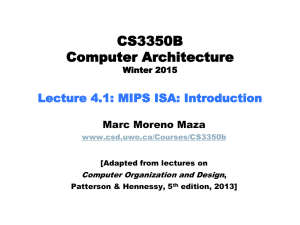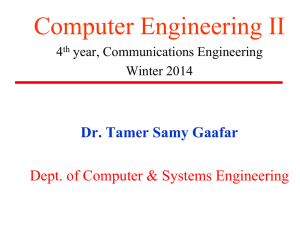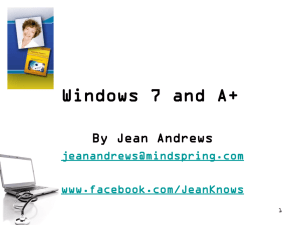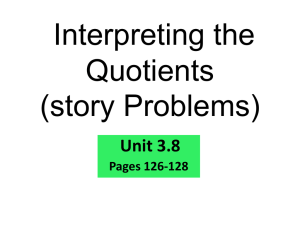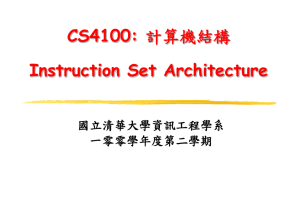L1-ISA - Peer Instruction for Computer Science
advertisement
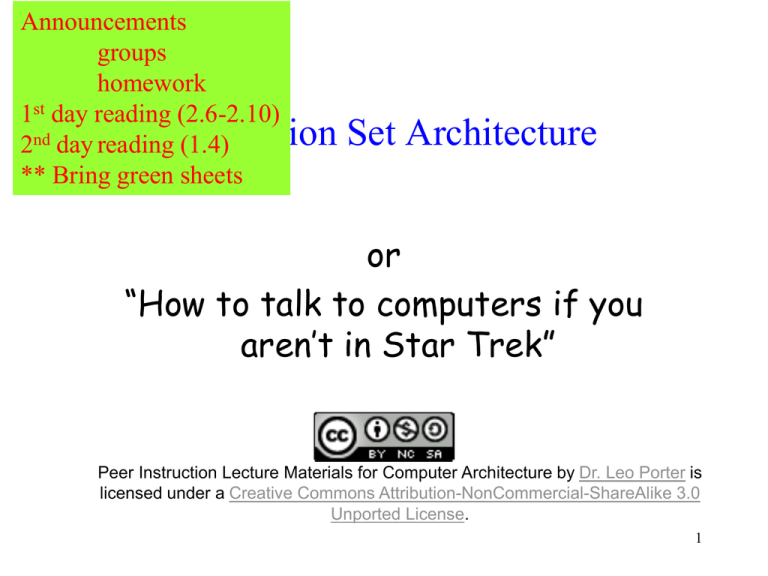
Announcements
groups
homework
1st day reading (2.6-2.10)
2nd day readingInstruction
(1.4)
** Bring green sheets
Set Architecture
or
“How to talk to computers if you
aren’t in Star Trek”
Peer Instruction Lecture Materials for Computer Architecture by Dr. Leo Porter is
licensed under a Creative Commons Attribution-NonCommercial-ShareAlike 3.0
Unported License.
1
What is Computer Architecture?
Computer Architecture = What the machine
Machine Organization + looks like
Instruction Set Architecture
How you talk to the machine
2
How to speak computer?
lw $15, 0($2)
lw $16, 4($2)
sw $16, 0($2)
sw $15, 4($2)
1000110001100010000000000000000
1000110011110010000000000000100
1010110011110010000000000000000
1010110001100010000000000000100
1
2
ALUOP[0:3] <= InstReg[9:11] & MASK
3
temp = v[k];
v[k] = v[k+1];
v[k+1] = temp;
4
Selection High Level Assembly
Language
Machine Language
Control
Signal Spec
A
4
2
1
3
B
4
1
2
3
C
3
1
2
4
D
3
2
1
4
E
None of the above
3
How to Speak Computer
High Level Language
Program
Discuss what classes
cover these parts + what
$15, 0($2)
$16, they
4($2)will do in the lab
Compiler
lw
lw
sw $16,
sw $15,
Assembly Language
Program
0($2)
4($2)
Assembler
1000110001100010000000000000000
1000110011110010000000000000100
1010110011110010000000000000000
1010110001100010000000000000100
Machine Language
Program
Machine Interpretation
Control Signal Spec
ALUOP[0:3] <= InstReg[9:11] & MASK
4
The Instruction Set Architecture
° is the agreed-upon interface between all the software that runs on the
machine and the hardware that executes it.
Application
Operating
System
Compiler
Instr. Set Proc.
I/O system
Instruction Set
Architecture
Digital Design
Circuit Design
More in Chapter 2
Talk about impact of legacy
code.
5
The Instruction Set Architecture
•
that part of the architecture that is
visible to the programmer
-
opcodes (available instructions)
number and types of registers
instruction formats
storage access, addressing modes
exceptional conditions
You will make this in the
lab!
6
Which of the following statement is
generally true about ISAs?
Select Statement
A
B
Many models of processors can support one
ISA.
An ISA is unique to one model of processor.
C
Every processor supports multiple ISAs.
D
Each processor manufacturer has its own
unique ISA.
E
None of the above
7
Examples of ISAs
•
•
•
•
•
•
•
•
•
Intel 80x86/pentium
VAX
MIPS
SPARC
Alpha AXP
IBM 360
Intel IA-64 (Itanium)
PowerPC
IBM Cell SPE
Main point – many
machines map to 1 ISA
8
Computer Organization
•
Once you have decided on an ISA, you
must decide how to design the
hardware to execute those programs
written in the ISA as fast as possible
- (or as cheaply as possible, or using as little
power as possible, …).
•
This must be done every time a new
implementation of the architecture is
released, with typically very different
technological constraints.
9
You’ve learned ISAs – now we’re focusing on DESIGNING ISAs
Key ISA decisions
destination operand
• operations
how many?
which ones
• operands
how many?
location
types
how to specify?
• instruction format
operation
y=x+b
source operands
(add r1, r2, r5)
how does the computer know what
0001 0100 1101 1111
means?
size
how many formats?
10
Your architecture supports 16 instructions and
16 registers (0-15). You have fixed width
instructions which are 16 bits. How many
register operands can you specify (explicitly) in
an add instruction?
Selection
operands
A
<= 1
B
<= 2
C
<= 3
D
<= 4
E
None of the
above
LAB!!! (Specify vs. have --- implicit)
Just have them discuss for ~1 min.
11
Your architecture supports 16 instructions and
32 registers (0-31). You have fixed width
instructions which are 16 bits. How many
register operands can you specify (explicitly) in
an add instruction?
Selection operands
A
<= 1
B
<= 2
C
<= 3
D
<= 4
E
None of the
above
LAB!!!
Just have them discuss for ~1 min.
Also point out impact of 32 instructions and MIPS funct trick
12
Instruction Formats
-what does each bit mean?
• Having many different instruction formats...
• complicates decoding
• uses more instruction bits (to specify the format)
VAX 11 instruction format
Serial decoding
13
MIPS Instruction Formats
6 bits
5 bits
opcode
rs
rt
opcode
rs
rt
opcode
5 bits
5 bits
5 bits
6 bits
rd
sa
funct
immediate
target
Would be really hard to have less than three
Much more than three makes decoding more serial, again
14
MIPS Instruction Formats
6 bits
5 bits
opcode
rs
rt
opcode
rs
rt
opcode
R-type
A
B
C
D
E
5 bits
5 bits
5 bits
6 bits
rd
sa
funct
immediate
target
I-type
addi
sw
addi
sub
add
sw
add
sub
None of the above
J-type
jr
jal
jr
jal
15
Convert this MIPS machine instruction to
assembly:
ISOMORPHIC
A
0010 0001 0001 0000 0000 0000 0010 0010
Selection
A
B
C
D
E
Instruction
addi r16, r8, #34
addi r8, r16, #34
sub r8, r16, r31
sub r31, r8, r16
None of the above
16
Convert this MIPS machine instruction to
assembly:
ISOMORPHIC
C
1000 1101 0001 0000 0000 0000 0000 1000
Selection
A
B
C
D
E
Instruction
jr r16
jr r8
lw r16, 8 (r8)
lw r8, 8 (r16)
None of the above
17
Convert this MIPS machine instruction to
assembly:
A is correct
0000 0001 0001 0000 1111 1000 0010 0100
Selection
A
B
C
D
E
Instruction
and r31, r8, r16
and r8, r16, r31
add r8, r16, r31
sub r31, r8, r16
None of the above
18
Accessing the Operands
There are typically two locations for operands – registers (internal
storage - $t0, $a0) and memory. In each column we have which - reg
or mem - is better. Which row is correct?
A
Faster
access
Mem
Fewer bits to More
specify
locations
Mem
Reg
B
Mem
Reg
Mem
C
Reg
Mem
Reg
D
Reg
Reg
Mem
E
None of the above
19
Explain each – but then point out how this leads to load/store
Load-store architectures
can do:
add r1=r2+r3
and
load r3, M(address)
can’t do
add r1 = r2 +
M(address)
forces heavy
dependence on
registers, which is
exactly what you want
in today’s CPUs
- more instructions
+ fast implementation
(e.g., easy pipelining)
Which is it that we care about?
Why else can’t do address? (hint – fixed instruction length)
20
How Many Operands?
Basic ISA Classes
Accumulator:
1 address
Stack:
0 address
add A
acc acc + mem[A]
Talk through each one – just describe what it is.
Not in the text – but on the CD. Be sure to
mention
stacks tos
often
use internal registers
add
tos + next
General Purpose Register:
2 address
3 address
add A B
add A B C
EA(A) EA(A) + EA(B)
EA(A) EA(B) + EA(C)
add Ra Rb Rc
load Ra Rb
store Ra Rb
Ra Rb + Rc
Ra mem[Rb]
mem[Rb] Ra
Load/Store:
3 address
21
A = BC+BY
Stack
Push B
pushY mult
pushb
pushC mult
add popA
Acc
Load B multY
store temp
Load B Mult C
add temp store
A
Reg-Mem
R1=B*Y
R2=B*C
A=R1+R2
Reg-Reg
R1=B R2=C
R3=Y
R4=R1*R2
R5=R1*R3
R6=R4+R5
A=R6 22
A = BC+XY
ISOMORPHIC
Stack
Acc
Reg-Mem
Reg-Reg
push B
Load B
R1 = B*C
R1 = B
push C
Mult C
R2 = X*Y
R2 = C
push X
Store temp
A = R1+R2
R3 = X
push Y
Load X
R4 = Y
Mult
Mult Y
R5 = R1*R2
Mult
Add temp
R6 = R3*R4
add
Store A
R7 = R5+R6
pop A
A = R7
In an alternative universe, memory is VERY SLOW to access relative to registers
(internal storage). Which ISA would you most likely find in this universe?
A. Stack
B. Accumulator
Explain that these are
C. Reg-Reg
sample codes – but the
D. Accumulator and Reg-mem
question is in general 23
E. Stack and Accumulator
A = BC+XY
Stack
Acc
Reg-Mem
Reg-Reg
pushB
Load B
R1 = B*C
R1 = B
pushC
Mult C
R2 = X*Y
R2 = C
push X
Store temp
A = R1+R2
R3 = X
push Y
Load X
R4 = Y
Mult
Mult Y
R5 = R1*R2
Mult
Add temp
R6 = R3*R4
add
Store A
R7 = R5+R6
pop A
A = R7
In an alternative universe – registers (internal storage) are very
expensive, and memory is not as slow. Which ISA would you most
likely find in this universe?
A.Stack
B.Accumulator
C.Reg-Reg
D.Reg-Mem and Stack
E.Both Reg-Reg and Reg-Mem
24
Option
Example/description
1
Memory[R7]
2
R7
3
4
5
A
B
C
D
E
Match the
addressing mode
with its example:
I’m not a big fan of
memorizing “terms” but
Memory[R7 + 1000]
these are used frequently
Memory[1000]
enough that you need to
know them.
Immediate Register Memory Register Base +
Direct
Direct
Indirect displacement
1
2
3
4
5
3
4
5
1
2
3
1
2
4
5
2
4
5
1
3
25
None of the above
1000
MIPS addressing modes give flexibility
immediate
OP
Get reg ind and absolute for free
rs
rt
add $1, $2,
#35
rs
rt
base + displacement
lw $1, disp($2)
(R1 = M[R2 + disp])
immediate
immediate
register indirect
disp/immediate = 0
absolute
(rs) = 0
26
Memory Organization
•
•
•
Viewed as a large, single-dimension array, with an
address.
A memory address is an index into the array
Byte addressing
“______________"
means that the index points
to a byte of memory.
0
1
2
3
4
5
6
...
8 bits of data
8 bits of data
8 bits of data
8 bits of data
8 bits of data
8 bits of data
8 bits of data
27
Processor X is 16 bit byte-addressable. If you have a
pointer at address 0000 0000 0000 1000 and you increment
it by one (0000 0000 0000 1001). What does the new
pointer (0000 0000 0000 1001) point to, relative to the
original pointer (0000 0000 0000 1000)?
ISOMORPHIC
A) The next word in memory
B is correct
B) The next byte in memory
C) Either the next word or byte – depends on if you use that
address for a load byte or load word
D) Pointers are a high level construct – they don’t make
sense pointing to raw memory addresses.
E) None of the above.
28
Processor Y is 14 bit word-addressable. If you have a
pointer at address 00 0000 0000 1000 and you increment it
by one (00 0000 0000 1001). What does the new pointer (00
0000 0000 1001) point to, relative to the original pointer (00
0000 0000 1000)?
ISOMORPHIC
A) The next word in memory
A correct
B) The next byte in memory
C) Either the next word or byte – depends on if you use that
address for a load byte or load word
D) Pointers are a high level construct – they don’t make
sense pointing to raw memory addresses.
E) None of the above.
29
Reading Quiz Variant
•
You have the following code in C:
for(int i = 0; i< 10;i++){
A[i]=i;
}
Where A is an array of shorts (16 bit/half-word).
Let's suppose that the base address of A is in $s0
and has the value of 1000 (base ten).
What byte address(es) correspond to A[5]?
Selection
Byte(s)
A
1005
B
1010
C
1005-1006
D
1010-1011
E
None of the above
Byte word addressing can be problematic to think about – the book
Likes to jump around between them. I’ll try to be consistent in class.
30
Memory Organization
•
•
Bytes are nice, but most data items use larger
"words"
For MIPS, a word is 32 bits or 4 bytes.
0
4
8
12
•
•
•
32 bits of data
32 bits of data
32 bits of data
Registers hold 32 bits of data
32 bits of data
232 bytes with byte addresses from 0 to 2^32-1
230 words with byte addresses 0, 4, 8, ... 2^32-4
Words are aligned
i.e., what are the least 2 significant bits of a
word address?
31
MIPS Review
All our processors will be mips based – so just wanna go over it.
32
The MIPS ISA, so far
•
•
•
•
fixed 32-bit instructions
3 instruction formats
3-operand, load-store architecture
32 general-purpose registers (integer, floating
point)
- R0 always equals 0.
•
•
•
2 special-purpose integer registers, HI and LO,
because multiply and divide produce more than 32
bits.
registers are 32-bits wide (word)
register, immediate, and base+displacement
addressing modes
33
What’s left
• which instructions?
• odds and ends
34
Which instructions?
•
•
•
•
•
arithmetic
logical
data transfer
conditional branch
unconditional jump
35
Which instructions (integer)
•
arithmetic
- add, subtract, multiply, divide
•
logical
- and, or, shift left, shift right
•
data transfer
- load word, store word
36
Control Flow
•
•
•
Jumps
Procedure call (jump subroutine)
Conditional Branch
- Used to implement, for example, if-then-else
logic, loops, etc.
•
A conditional branch must specify two
things
- Condition under which the branch is taken
- Location that the branch jumps to if taken
(target)
37
What form of addressing is used by branch
instructions?
Addressing Best explanation
Mode
A Absolute
Branch instructions require a full 32-bit
address to know the branch target
B Absolute
A 32-bit immediate gives us enough bits to
specify a full address
C Relative
Branches tend to be backward branches
which require a negative immediate
Branch targets tend to be close to the
branch instruction
We can load a 32 bit full address in a
register – which lets us branch anywhere
D Relative
E Register
Indirect
Mention C isn’t incorrect – and branches tend to be backward, but if they weren’t
close – we couldn’t do relative
38
High level code often has code like this:
if(i<j) {
i++;
}
Assume $t0 has i and $t1 has j. (slt rd, rs, rt does: R[rd]=1 if
R[rs]<R[rt], else R[rd] = 0.) Which of the following is the correct
translation of the above code to MIPS assembly (recall $zero is
always 0):
slt $t2, $t0, $t1
bne $t2, $zero, false
addi $t0, $t0, 1
false: next instruction
A
slt $t2, $t0, $t1
beq $t2, $zero, false
addi $t0, $t0, 1
false: next instruction
D
slt $t2, $t1, $t0
bne $t2, $zero, true
true: addi $t0, $t0, 1
next instruction
B
slt $t2, $t1, $t0
beq $t2, $zero, false
addi $t0, $t0, 1
false: next instruction
C
Mention useless bne in B
D is correct
None of the above
E
39
Jump instructions have a 26-bit immediate.
Since an address must be word aligned we can
always use 00 as the lowest bits. To make a
32 bit address, what are the top 4 bits?
Top 4 bits Why (best answer)
A 0000
All instructions are at low addresses
B pc[3:0]
Low order bits of the current program
counter best represent the high bits of
the new pc
C pc[31:28] High order bits of the current program
counter since most jumps go to (relatively)
nearby instructions
D pc[31:28]
All instructions must be in the same
256MB segment.
E None of the above
40
What is the most common use of a jal
instruction and why?
Most
common
use
Best answer
A Procedure
call
Jal stores the next instruction in your
current function so the called function
knows where to return to.
B Procedure
call
Jal enables a long jump and most procedures
are a fairly long distance away
C If/else
Jal lets you go to the if while storing pc+4
(else)
Jal enables a long branch and most if
statements are a fairly long distance away
D If/else
E None of the above
Mention jr
41
To summarize:
MIPS operands
Name
32 registers
2 30 memory
words
Category
Arithmetic
Example
$s0-$s7, $t0-$t9, $zero,
$a0-$a3, $v0-$v1, $gp,
$fp, $sp, $ra, $at
Memory[0],
Memory[4], .. .,
Memory[4294967292]
add
Three operands ; data in regis ters
s ubtract
sub $s1, $ s2, $s3
$s1 = $s2 - $s3
Three operands ; data in regis ters
add immediate
load word
addi $s1, $s2, 100
lw $s1, 1 00($s2)
sw $s1, 1 00($s2)
lb $s1, 1 00($s2)
sb $s1, 1 00($s2)
lui $s1, 1 00
$s1 = $s2 + 100
$s1 = Memory[ $s2 + 100]
Memory[ $s2 + 100] = $s1
$s1 = Memory[ $s2 + 100]
Memory[ $s2 + 100] = $s1
$s1 = 100 * 2 16
Us ed to add constants
Word from memory to regis ter
load by te
s tore by te
load upper
immediate
Unconditional jump
Comments
Word from regis ter to memory
Byte from memor y to register
Byte from register to memory
Loads c onstant in upper 16 bits
beq
$s1, $s2, 25
if ($s1 == $s2 ) go to
PC + 4 + 100
Equal tes t; PC-relative branch
branch on not equal bne
$s1, $s2, 25
if ($s1 != $s2 ) go to
PC + 4 + 100
Not equal test; PC -relativ e
$s1, $s2, $s3
if ($s2 < $s3 ) $s1 = 1;
els e $s1 = 0
Compare less than; for beq, bne
branch on equal
Conditional
branch
Acc es sed only by data trans fer instruc tions. MIPS us es byte addres ses, s o
s equential words differ by 4. Memory holds data struc tures , suc h as array s,
and s pilled regis ters, s uc h as thos e saved on procedure calls.
MIPS assemb ly language
Meaning
Example
$s1 = $s2 + $s3
add $s1, $ s2, $s3
Instruction
s tore word
Data transfer
Comments
Fas t locations for data. In MIPS, data mus t be in registers to perform
arithmetic. MIPS register $z ero alway s equals 0. Regis ter $at is
reserved for the as sembler to handle large constants .
s et on less than
slt
s et les s than
immediate
slti
jump
j
jr
jal
jump register
jump and link
$s1, $s2, 100 if ($s2 < 100 ) $s1 = 1;
Compare less than c onstant
els e $s1 = 0
2500
$ra
2500
J ump to target addres s
go to 10000
For switc h, proc edure return
go to $ra
$ra = PC + 4; go to 10000 For procedure c all
42
Review -- Instruction Execution in a CPU
Memory2
Registers10
R0
R1
R2
R3
R4
R5
...
0
36
60000
45
198
12
...
CPU
Program
Counter
address10:
Watch lw typo
On cheat sheet
10000 10001100010000110100111000100000
10004 00000000011000010010100000100000
10000
Instruction Buffer
57
op
rs
rt
rd
shamt
80000 00000000000000000000000000111001
immediate/disp
in1
operation
in2
ALU
out
addr
Load/Store
Unit
data
What happens when you execute
the next instruction?
A. PC=10004
B. R[R3] = 80000
C. R[R3] = 57
D. Both A and B
E. Both A and C
43
Review -- Instruction Execution in a CPU
Memory2
Registers10
R0
R1
R2
R3
R4
R5
...
0
36
60000
45
198
12
...
op
CPU
UPDATE! 10004 and R3=57
Program
Counter
address10:
10000 10001100010000110100111000100000
10004 00000000011000010010100000100000
10000
Instruction Buffer
rs
rt
rd
shamt
80000 00000000000000000000000000111001
immediate/disp
in1
operation
in2
ALU
out
addr
Load/Store
Unit
data
What happens when you execute
the next instruction?
A. PC=10008
B. R[R5] = 93
C. R[R3] = 48
D. Both A and B
E. Both A and C
44
Key Points
•
•
•
•
MIPS is a general-purpose register, loadstore, fixed-instruction-length architecture.
MIPS is optimized for fast pipelined
performance, not for low instruction count
Historic architectures favored code size
over parallelism.
MIPS most complex addressing mode, for
both branches and loads/stores is base +
displacement.
45


